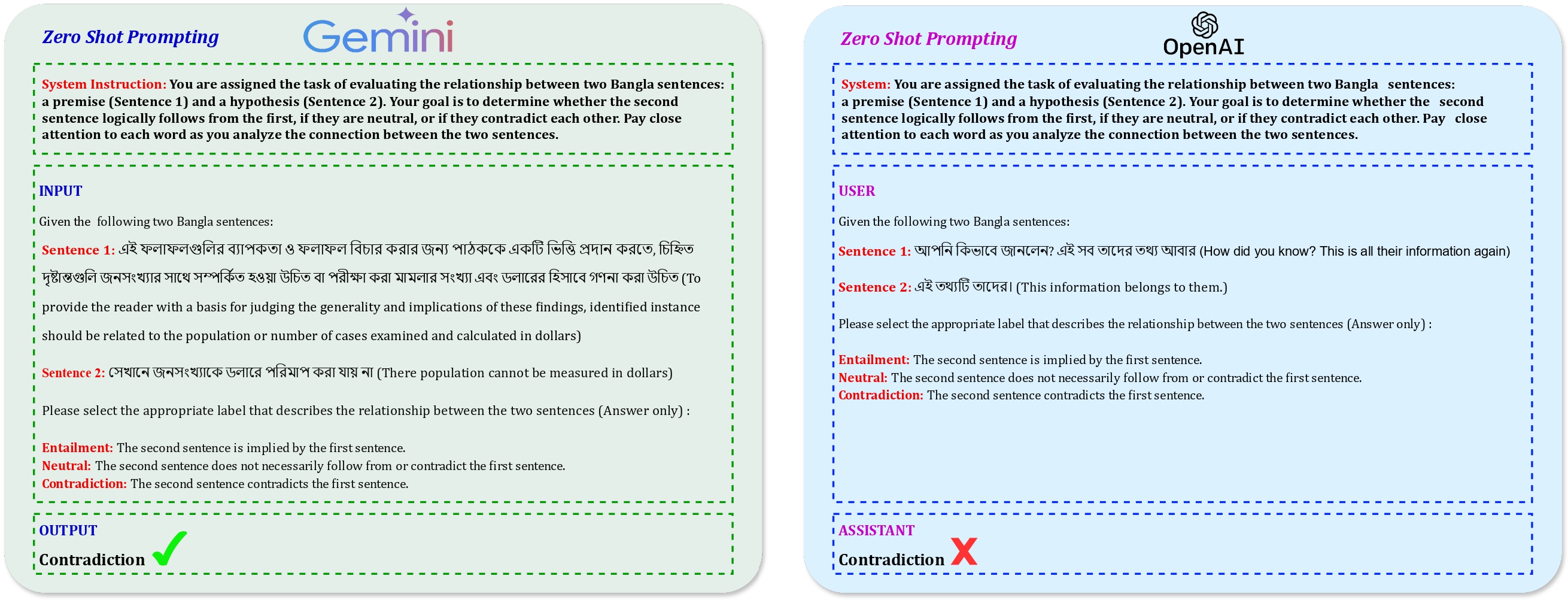Unraveling the Dominance of Large Language Models Over Transformer Models for Bangla Natural Language Inference: A Comprehensive Study
Natural Language Inference (NLI) plays a critical role in Natural Language Processing (NLP) as it uncovers entailment relationships between text pairings, crucial for Natural Language Understanding (NLU). NLI evaluates entailment between a premise and a hypothesis, where "entailment" denotes logical implication, "contradiction" indicates disagreement, and "neutral" suggests inadequate evidence. Despite the success of Large Language Models (LLMs), challenges persist in NLI, particularly in low-resource domains, model overconfidence, and capturing human judgment. This work investigates the efficacy of LLMs in low-resource languages like Bengali by comparing notable LLMs with state-of-the-art (SOTA) models using the XNLI dataset. Evaluations encompass zero-shot and few-shot scenarios, contrasting GPT-3.5 Turbo and Gemini 1.5 Pro against BanglaBERT, Bangla BERT Base, DistilBERT, mBERT, and SahajBERT. While LLMs exhibit promise, especially in few-shot settings, further research is warranted for a comprehensive understanding, particularly in languages like Bengali. This underscores the significance of continued exploration into LLM capabilities across diverse language contexts. Our implementations are now publicly accessible at https://github.com/fatemafaria142/Large-Language-Models-Over-Transformer-Models-for-Bangla-NLI.
In this research paper, we have employed the XNLI dataset, which comprises Bengali-language instances for NLI. The dataset consists of a subset of the MultiNLI data, where each instance includes a premise (sentence1), a hypothesis (sentence2), and a classification label indicating contradiction (0), entailment (1), or neutral (2).
We utilized the following number of instances from each set:
- Train set: 381,449 instances
- Validation set: 2,419 instances
- Test set: 4,895 instances
The dataset can be accessed from here.
| Model | Accuracy | Precision | Recall | F1-Score |
|---|---|---|---|---|
| BanglaBERT | 0.8204 | 0.8222 | 0.8204 | 0.8203 |
| Bangla BERT Base | 0.6803 | 0.6907 | 0.6812 | 0.6833 |
| DistilBERT | 0.6320 | 0.6358 | 0.6320 | 0.6317 |
| mBERT | 0.6427 | 0.6496 | 0.6428 | 0.6153 |
| sahajBERT | 0.6708 | 0.6791 | 0.6709 | 0.6707 |
| LLMs | Metric | Zero-shot | 5-shot | 10-shot | 15-shot |
|---|---|---|---|---|---|
| GPT-3.5 Turbo | Accuracy | 0.8503 | 0.8657 | 0.8756 | 0.9205 |
| Precision | 0.7025 | 0.8683 | 0.8753 | 0.9219 | |
| Recall | 1.0 | 0.8624 | 0.8759 | 0.9204 | |
| F1-Score | 0.8254 | 0.8640 | 0.8748 | 0.9299 | |
| Gemini 1.5 Pro | Accuracy | 0.7287 | 0.8625 | 0.8732 | 0.9146 |
| Precision | 0.5556 | 0.8652 | 0.8763 | 0.9156 | |
| Recall | 0.7143 | 0.8652 | 0.8732 | 0.9146 | |
| F1-Score | 0.6251 | 0.8652 | 0.8701 | 0.9136 |
For any questions, collaboration opportunities, or further inquiries, please feel free to reach out:
-
Fatema Tuj Johora Faria
- Email: fatema.faria142@gmail.com
-
Mukaffi Bin Moin
- Email: mukaffi28@gmail.com
-
Pronay Debnath
- Email: pronaydebnath99@gmail.com
-
Asif Iftekher Fahim
- Email: fahimthescientist@gmail.com
@misc{faria2024unraveling,
title={Unraveling the Dominance of Large Language Models Over Transformer Models for Bangla Natural Language Inference: A Comprehensive Study},
author={Fatema Tuj Johora Faria and Mukaffi Bin Moin and Asif Iftekher Fahim and Pronay Debnath and Faisal Muhammad Shah},
year={2024},
eprint={2405.02937},
archivePrefix={arXiv},
primaryClass={cs.CL}
}
